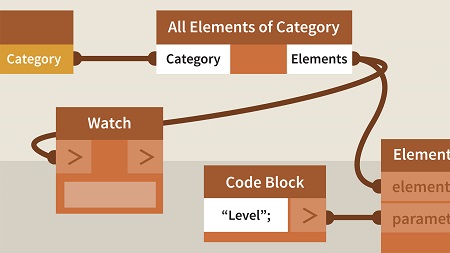
English | MP4 | AVC 1280×720 | AAC 48KHz 2ch | 3h 37m | 615 MB
Can’t find the Dynamo node you need? Python allows you to create powerful custom nodes that extend the functionality of Dynamo and solve your Revit modeling challenges in smarter, faster ways. This course introduces the Python programming language to designers who want to do more with Dynamo. First, learn the basics of Python, including data types, conditionals, and loops, while interacting directly with Dynamo Geometry library. Then find out how to extend the functionality with Dynamo with libraries such as the Revit API. In chapter four, you put your new skills to work. Instructor and BIM expert Jeremy Graham shows how to use Python and the Revit API to filter elements, access parameters, and create custom views.
Note: This course uses Dynamo 2.0.1 and Revit 2019. For best results, it helps to have the same versions of the software.
Topics include:
- Importing the Dynamo Geometry library
- Python basics: variables, conditionals, operators, loops, and functions
- Using and extending Python modules
- Accessing the Revit API with Python
- Revit and Dynamo conversions
- Creating a collector in the Revit API
- Getting Revit parameters with the Revit API
- Adjusting elements with the Revit API
- Creating views with the Revit API
Table of Contents
Introduction
1 Jumping into Python and Dynamo
2 What you should know
3 Exercise files
Dynamo and Python
4 The Python node basics
5 What is OOP
6 Importing the Dynamo library
Python Basics
7 Defining variables
8 Numbers
9 Strings
10 Working with lists
11 Making decisions with conditionals
12 Control with operators
13 Logical operators
14 Looping with the for loop
15 Looping with the while loop
16 Break and continue
17 Nested loops
18 Dictionaries
19 Try and except
20 Defining functions
Working with Libraries
21 Built-in Python modules
22 Extending Python modules
23 Saving our own module
24 What is IronPython
25 Accessing Revit nodes
26 Importing the Revit API
27 Working with the Revit API
28 Revit conversions
29 Dynamo conversions
30 Navigating the Revit API
Revit API
31 Collecting elements
32 Creating a collector
33 Getting Revit parameters
34 Setting Revit parameters
35 Creating line-driven elements
36 Element locations
37 Adjusting elements
38 Creating a view
39 View bounding boxes
40 Revit API and IronPython types
Conclusion
41 Next steps
Resolve the captcha to access the links!